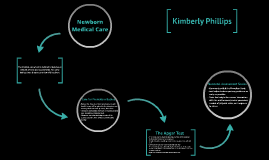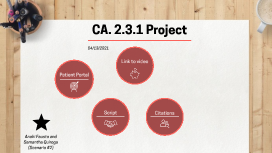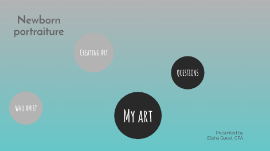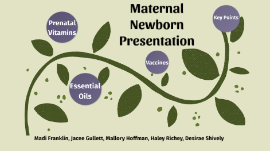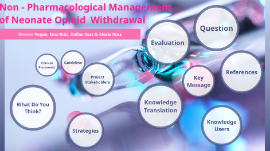Family Newborn Presentation
Transcript: Non - Pharmacological Management of Neonate Opioid Withdrawal Kirsten Pogue, Ema Ruiz, Dallas Ross & Alexis Ross What are a few interventions you may do for this baby? What Do You Think? What Do You Think? https://www.youtube.com/watch?v=5Te5Wfpi8HU Clinical Placement Clinical Placement Unit 53 - Postpartum Unit Unit 53 - Postpartum Unit Peterlougheed Centre (Maternity Services, (n.d.) Perinatal Opioid Exposure - Care of the Baby Guideline Guideline (BC Women’s Hospital & Health Centre, 2002). - Three parts: Assessments Interventions (Pharmacological and Non-Pharmacological) & Discharge Criteria - Neonatal Abstinence Score (AHS) does not include non-pharmacological interventions - Policy implemented in 1986 Current Policy in Use on Unit 53 Current Policy in Use on Unit 53 (Calgary Health Region, 1986). Project Stakeholders Project Stakeholders (Mount Royal University, 2017) Policy Makers Policy Makers Create new policy for non-pharmacological interventions Translate best practice to new standards and policies Involved before and during implementation Managers Managers Implement and enforce usage of new policy Advocate for change Ensure staff is aware, educated and using the new policy Involved in all stages Nurse Educators & Charge Nurse Nurse Educators & Charge Nurse Teach and enforce new policy Advocate for policy changes Involved before, during, and after implementation Doctors (GP/Pediatrician/Obstetrician) Doctors (GP/Pediatrician/Obstetrician) Responsible for mother and baby Provide care orders and ensure best practice Traditionally have larger political voice Advocate and carry out new policy Involved in all steps of the process Nurses Nurses Use policy and protocol in daily practice Must be aware and educated on how to properly use Responsible to educate patient and family advocate for policy change Involved before, during and after implementation Mothers & Family Mothers & Family (If determined appropriate) included in care Used after implementation Knowledge Users Knowledge Users (Mount Royal University, 2017) Nurses Nurses Practice change Behaviour change Doctors (GP/Pediatrician/Obstetrician) Doctors (GP/Pediatrician/Obstetrician) Practice change Behaviour change Parents and Family Parents and Family Awareness Intrest Non-pharmacological measures should be incorporated into neonatal abstinence scoring as well as pharmacological. For example, if the newborn has a score of (x or more), non-pharmacological measures should be implemented. These include skin to skin, swaddling, cuddling, non nutritive sucking, vertical rocking, tummy time, c-position and environmental stimulation control. Key Message Key Message (Mount Royal University, 2017) Policy Change - How do users implement? Nurses - Practice & Behaviour Change Doctors - Practice & Behaviour Change Parents/family - Awareness & Interest Knowledge Translation Knowledge Translation (Mount Royal University, 2017) Focus - Utilizing Managers, Charge Nurses and Nurse Clinicans to educate Nurses Strategies Strategies (Mount Royal University, 2017) Interactive Small Group Inservice Lead by nurse Educators & Managers to Nursing staff Teach nurses: How to properly use new protocol Why it is important To remain accountable through documentation To evaluate own biases Interactive Small Group Inservice Education Outreach Managers, Nurse Educator and Charge Nurse assist and check up on care provided to newborns in withdrawal Assess if using protocol correctly Provide support and education during care Education Outreach Were our goals met? What changes occurred? What is the timeline? Evaluation Evaluation (Mount Royal University, 2017) How Do We Know Are Goals Are Being Met? How Do We Know Are Goals Are Being Met? Nurses are: Overcoming bias Aware of protocol Aware of interventions' effectiveness Providing interventions Interventions are being charted and documented as done Bring in auditors to check charting and compliance rates Managers, educators & charge checking in 100% nursing staff attendance to in-service How Do We Measure That Change is Occuring? How Do We Measure That Change is Occuring? Unit staff, including casual staff trained within three months of implementation Evaluate compliance directly after inservice completion Look for improvements Timeline Timeline You are working with a new mother and her newborn who are four hours postpartum. The charge nurse informs you that the mother had a hisotry of using heroine (a street opiate drug) throughout her pregnancy. The baby is showing signs of neonatal abstinence syndrome. You now expect to carry out which of the following interventions? (Choose all that apply!) A. Skin To Skin B. Adjust Environmental Stimulation C: Take Newborn Away From Mother to Nursery D: Complete neonatal abstinence form and determine correct morphine dose E: Turn on all the lights in the room to assess the baby Question Question BC Women’s Hospital & Health Centre. (2002). Perinatal opioid exposure – Care of the baby. Vancouver,






